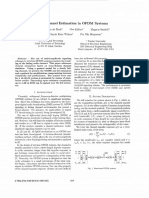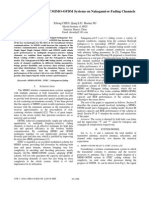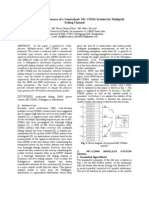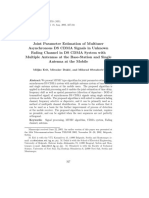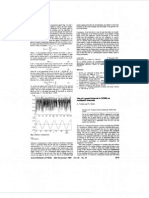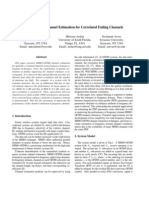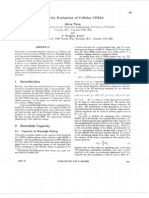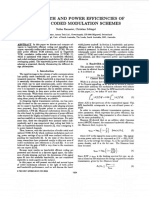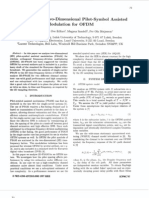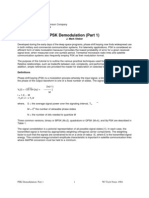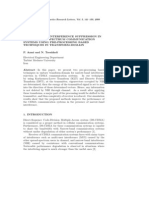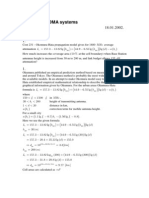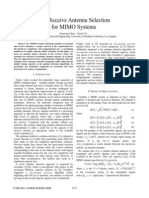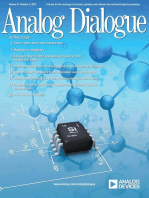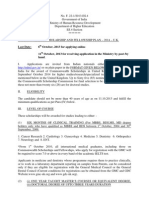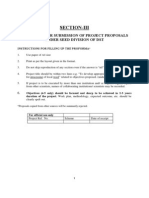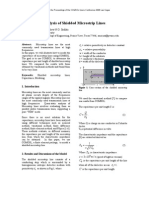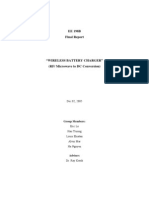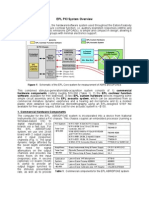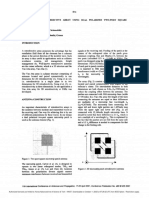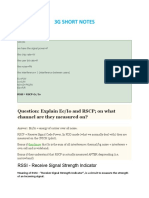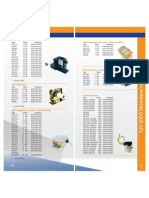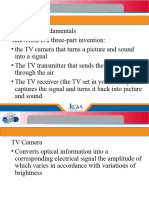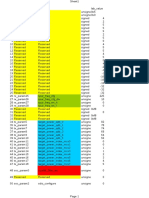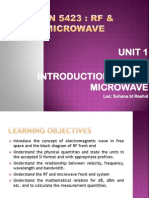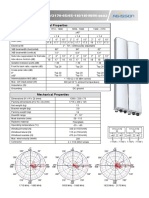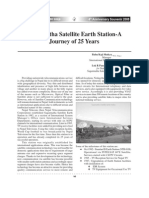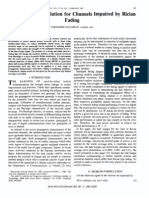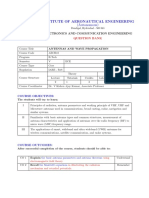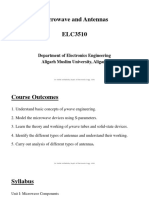Adaptive Beamforming For Ds-Cdma Using Conjugate Gradient Algorithm in Multipath Fading Channel
Adaptive Beamforming For Ds-Cdma Using Conjugate Gradient Algorithm in Multipath Fading Channel
Uploaded by
V'nod Rathode BCopyright:
Available Formats
Adaptive Beamforming For Ds-Cdma Using Conjugate Gradient Algorithm in Multipath Fading Channel
Adaptive Beamforming For Ds-Cdma Using Conjugate Gradient Algorithm in Multipath Fading Channel
Uploaded by
V'nod Rathode BOriginal Description:
Original Title
Copyright
Available Formats
Share this document
Did you find this document useful?
Is this content inappropriate?
Copyright:
Available Formats
Adaptive Beamforming For Ds-Cdma Using Conjugate Gradient Algorithm in Multipath Fading Channel
Adaptive Beamforming For Ds-Cdma Using Conjugate Gradient Algorithm in Multipath Fading Channel
Uploaded by
V'nod Rathode BCopyright:
Available Formats
ADAPTIVE BEAMFORMING FOR DS-CDMA USING CONJUGATE GRADIENT ALGORITHM IN A MULTIPATH FADING CHANNEL
Nermin A. Mohamed. James G. Dunham Department of Electrical Engineering Southern Methodist University, Dallas, TX 75275 PH: 214-768-3112 FAX:214-768-3573 e-mail: nermin @ seas.smu.edu, jgd @seas.smu.edu
Abstract - An antenna array-based base station receiver for wireless DS-CDMA with Conjugate Gradient (CG) adaptation in a multipath fading channel is studied. In order to construct a beamformer-RAKE receiver, the existing code-filtering approach is used for each resolvable multipath component of the desired user: however, with another way to determine the optimum antenna weights. Thus, the desired user's signal is enhanced and the co-channel interference from other directions is reduced. The average uncoded Bit Error Rate (BER) as a function of the average antenna Signalto-Noise Ratio (SNR) and the number of receiving antennas is examined in a frequency selective Rayleigh fading channel. Simulation results show an increase in system capacity proportional to the number of antennas.
I.
INTRODUCTION
In recent years, the growing demand for mobile communication systems, in particular cellular systems, has lead to ways of increasing the channel capacity within the allocated spectrum to these services while maintaining satisfactory performance. One approach for increased spectrum efficiency in digital cellular is the use of Direct Sequence-Code Division Multiple Access (DS-CDMA) technology [ 11. Another promising approach that is applicable to the DS-CDMA systems is the use of spatial processing with cell site adaptive antenna arrays. Beamforming and adaptive antenna arrays are very efficient capacity enhancement techniques [3-81. They have been proposed to reduce multipath fading of the desired signal and to suppress the co-channel interference. A new space-time processing framework for adaptive beamfonning with antenna arrays in CDMA was proposed by A. Naguib [8]. This system uses code-filtering approach in each receiving antenna to estimate both the channel vector and the optimum beamformer weights.
In our work, we assume perfect estimation of the channel parameters (direction; delay; and power) for the desired user [2]. We use the Conjugate Gradient (CG) adaptation algorithm to find the optimum beamformer weights [lo, 111. CG adaptation has two main characteristics. First, it can produce a solution of the matrix equation very efficiently and converge in a finite number of iterations (the number of the unknown weights). This is very important if the array is to operate in a mobile system in which a high speed of convergence is required. Second, the convergence is guaranteed for any possible condition of the signal matrix. Note that, unlike other adaptive algorithms, the number of weights is less than the number of sensors0.5 x (1 + number of sensors) [ 10, 113. The resolvable paths' directions are fed to the CG beamformer to cancel out the co-channel interference from other directions. The RAKE fingers are then coherently combined to form a decision statistic for the desired user [7]. The rest of the paper is organized as follows. Section two describes the system. In section three, we review the CG adaptive algorithm. Simulation results will be presented in section four. Finally, section five summarizes the paper.
1 1 .
SYSTEM DESCRIPTION
We assume that the base station uses an antenna array of P sensors and N weights, where P = 2N - 1, to receive signals from mobiles. Let K be the number of users in the cell. For simplicity, we assume that the mobile uses BPSK modulation, however, any modulation format can be used. Additionally, assume a slow fading L-paths channel (the channel random parameters do not change within the symbol time interval) with correlated coefficient generated by Jake's model [9]. The received signal at the p'* antenna elemeni can be shown to be
0-7803-5554-7/99/$10.00 Q IEEE.
x p ( t )=
i ~ i h (-T,,)c,(r t - T , . , ) ~ , , ~ - " ~ / " " " I+ I '4 2 )
,=I
1-1
(1)
where p = -(N - I ) , - . - , ( N - 1); c , ( t ) E {l,- l} is the (square pulse) Pseudo Noise (PN) chips of the ilh mobile with a chip period of T,; P I is the average transmitted ~ is the ' i mobile mobile power; b , ( r ){I,-]} information bit sequence with a bit period of T = GT, where G is the processing gain; T , , is the Irh path time delay for the i* mobile channel; @,,, IS the Direction of Arrival (DoA) of the lrh path of the ith mobile signal measured from the array broadside and a,,, is the complex Gaussian fading channel coefficient from the lrh path of the " i mobile to the antenna array; d is the distance between the antenna elements (d = U2 for no grating lobes); and finally n(t) is the thermal white Gaussian noise. Without loss of generality, assume the desired user is the first one. Then, Eq. (1) can be put in the following form
L
It is well known that an array of N weights has N-1 degree of freedom [ 1I]. This means that with an array of N weights, one can generates N-1 pattern nulls and a beam maximum in arbitrary directions. From Eq. ( I ) , it is clear that the number of interferers is K x L - 1. To null all of these interferers, one would have to have K x L weights which is not practical. In our work, we focus only on the L paths of the desired user (interpath interference). Thus, the minimum number of the antenna array weights is L where typically L varies from 2 to 6. The block diagram of the space-time matched filter is shown in Fig. 1 in which the received signal vector is spatially processed by a CG beamforming circuit, one for each resolvable path ( L beamformers), followed by a ' matched filter is bank of L matched filters. The 1 matched to the code waveform in the P path c(t - T,.,) . The spatial matched filter or the beamformer weighf vector for the l* path is chosen so that the /Ih path is the main signal and the other L-1 paths are the interfering sources. The output signals from the L matched filters are combined according to the Maximal Ratio Combining (MRC) principle and then are fed into the decision circuit of the desired user. As will be seen from simulation results, choosing the weights this way not only will remove the inter path interference but also will reduce the multiple access interference.
X,(t)
= &cb,(f 1-1
-ql)c,
(f
- TI , ) a , , e
-,2lpd<m*, ( l i
+~ p ( o t n ( r ~
( 21
where ZJt), the multiple access interference, is
intenna # (N- 1)
a
Ix(r)! 1
1I
i i
.i
i
: #
!
CG beamformer
w;
zdn>
c,'(t - q 1 >
. o
1
i
:
.
: . . :
:
. . . :
:
CG beamformer NL weights
Temporal matched filter
MRC combiner
Fig. 1 CG space-time receiver.
111.
CG ALGORITHM
CG algorithm is used to solve the operator equation y = Aw, where A is the signal matrix and y is the excitation vector (contains the information of the desired signal where the first path is the desired signal) defined as
...
A=
x,
;and
(4)
...
'N-I
The fundamental principle is to select a set of vectors pi such that they are A-orthogonal, i.e. 4 p i , App = 0 for i # j . The optimum weights are obtained by minimizing (/r(n)l12 where r(n) = Aw(n) - y. The following sequence of computations is performed to optimize the weight vector w [lo-1 11.
1. w ( n + l ) = w(n)+ t ( n ) p(n);
2. r ( n ) = llA"r(n)ll' / 1lAp(n)]f ; 3. r(n+l) = r(n) + t(n) p(n); 4. p(0) = -AHr(0); 5. p(n+l) = AHr(n+l)+ q(n) p(n); and 6. q ( n ) = IIA"r(n + 1)112/ llA"r(n)l12.
(6) (7) (8) (9) (10) ( 1 1)
Fig. 3 shows the antenna array magnitude response as a function of the Direction of Arrival (DoA) of the receiving users' signals and the number of the antenna elements. Path #2 is considered as the desired signal while paths #1 and #3 are considered as the interfering sources. The S N R is 25 dB. Fig. 4 shows the average BER as a function of the S N R for the CG beamformer in case of 16 active users. For comparison issues, the performance of the 1, 2, 3-fingers RAKE receiver (no beamfonning) are also shown. The performance of the CG beamformer was tested for different number of antenna weights (3, 5 , 7, and 9 weights). It is clear that there is a significant performance improvement proportional to the number of antenna weights. However, we still have the error floor because the multiple access interference is not completely eliminated. In Fig. 5 , we plot the average BER as a function of the number of the antenna weights at S N R = 25 dB while considering 16, 10 and 6 users in the cell. The surface plot in Fig. 6 shows the BER as a function of the SNR and the number of antenna weights. Finally the plots in Fig. 7 show the average BER improvements as a result of the CG beamformer. At BER = we can see that the capacity increased from 7 to 12 users. That is 70% capacity improvement.
IV.
SIMULATION RESULTS
The simulation situation shown in Fig. 2 is considered. We consider a base station with a uniform linear array of P omni-directional antennas with antenna spacing U2. We assumed BPSK Gold code spreading with processing gain G of 128. The input data rate is 9.6 Kbps (192 bits in a 20 msec frame). The channel bandwidth is 9600 x 128 = 1.2288 MHz. We considered K mobiles randomly distributed in azimuth around the base station with a uniform distribution over [-d2, d 2 ] . We also assume that three propagation paths are received from each mobile as a result of dominant reflectors and that the total received power from each user is the same for all users (perfect power control). The paths' DoA's; time delays; and the power for the user of interest are shown in Table 1 where T, is the chip duration. Table 1 User #1 channel model. I Path# 1 1 Path#2 I DoA (degree) I -20 I 10 Time delay I0 I 2 Tc I 0.5 Power I 0.25
I Path#3
I 40
I4Tc
Dominant reflector
Fig. 2. Simulation diagram.
I 1.0
0 .
.so
g
4
h
-100.
Number 01 users = 16
I
-- _
-150.
2 .zoo.
Fig. 3 Array magnitude response versus the DoA and the number of weights
1oo
SNR in dB
1-
16 active users
Number 01 weights
I-bger
2-fmper a
3-fmper
Fig. 6 BER versus the SNR and the number of the CG weights.
I
10d
I
2
4
10
dB
12
14
16
SNR
in
Fig. 4 BER versus SNR with and without CG beamforming.
10
11
12
13
14
15
16
Number 01 users
Fig. 7 Average BER improvement by using the CG beamforming.
Fig. 5 BER versus the number of the CG weights and the number of the active users.
V.
CONCLUSIONS
electromagnetics, IEEE Trans Ant. & Prop., Vol AP33, NO. 10,pp. 1058-1066, Oct. 1985.
(1 1)R. T. Compton, Jr., The power inversion adaptive array: concept and performance, IEEE Trans. Aerospace & Electronic systems, Vol. 15, No. 6, pp. 803-814, NOV.1979.
We have presented a beamforming technique for DSCDMA using a low-complexity and fast adaptation algorithm. The proposed technique enhances the desired user signal and suppresses the co-channel interference from other directions. Thus, the system capacity (maximum number of allowable users per cell) is increased. For future work, we will consider an interference cancellation scheme together with this system to cancel out the in-beam interference [12].
(12)Nermin A. Mohamed and J. G. Dunham, A simple combined conjugate gradient beamforming and interference cancellation scheme for DS-CDMA in a multipath fading channel, Submitted to the E E E WCNC99.
REFERENCES
(1) A. J. Viterbi, Principles of Spread Spectrum Multiple Access Communications, MA: AddisonWesley, 1995.
( 2 ) J. Proakis. Digital Communications, 31d edition. McGraw-Hill. Inc., 1995.
(3) J. Litva, T. Kwok, and Yeung Lo, Digital Beamformino in Wireless Communications, Artech House Publishers, Boston, London, 1996.
(4) R. A. Monzingo and T. W. Miller, Introduction to Adaptive Arravs, NY: John Wiley and Sons, 1980.
A. Mohamed and J. G. Dunham. Performance analysis of CDMA mobile systems using antenna arrays and multi-user detection, Proceedings of the 32d Asilomar Conference on Signals, Systems and Computers, Nov. 1-4, 1998.
( 5 ) Nermin
( 6 ) Nermin A. Mohamed and J. G. Dunham, Performance analysis of an antenna array-based CDMA receiver using multi-user detection in a multipath Channel, Accepted for publication in the ZEEE VTCY9,Houston, TX, May 1999.
(7) B. Suard, A. Naguib, G. XU, and A. Paulraj. Performance analysis of CDMA mobile communication systems using antenna arrays, Proceedings of ICASSP93, vol. VI, MN, pp. 153-6, April 1993. (8) A. F. Naguib and A. Paulraj, Performance of wireless CDMA with M-ary orthogonal modulation and cell site antenna arrays, IEEE J . Select. Areas Commun., vol. 14, No. 9, pp, 1770-1783, Dec. 1995. (9) W. C. lakes, Microwave Mobile Communications. New York: John Wiley and Sons, 1974.
(10) T. K. Sarkar, and E. h a s , On a class of finite step iterative methods (conjugate directions) for solution of an operator equation arising in
You might also like
- Performance Analysis of Power Line Communication Using DS-CDMA Technique With Adaptive Laguerre FiltersDocument5 pagesPerformance Analysis of Power Line Communication Using DS-CDMA Technique With Adaptive Laguerre FiltersMasterArvinNo ratings yet
- Complex Simulation Model of Mobile Fading Channel: Tomáš Marek, Vladimír Pšenák, Vladimír WieserDocument6 pagesComplex Simulation Model of Mobile Fading Channel: Tomáš Marek, Vladimír Pšenák, Vladimír Wiesergzb012No ratings yet
- On Channel Estimation in OFDM SystemsDocument5 pagesOn Channel Estimation in OFDM SystemsSoumitra BhowmickNo ratings yet
- An Analysis of Pilot Symbol Assisted Modulation Rayleigh Fading ChannelsDocument8 pagesAn Analysis of Pilot Symbol Assisted Modulation Rayleigh Fading ChannelsBrijesh GuptaNo ratings yet
- S-38.220 Licentiate Course On Signal Processing in Communications, FALL - 97Document15 pagesS-38.220 Licentiate Course On Signal Processing in Communications, FALL - 97Shabeeb Ali OruvangaraNo ratings yet
- Channel Estimation EJSR 70-1-04Document8 pagesChannel Estimation EJSR 70-1-04حاتم الشرڭيNo ratings yet
- MIMO-Rake Receiver in WCDMADocument8 pagesMIMO-Rake Receiver in WCDMALê Minh NguyễnNo ratings yet
- Performance Analysis of A Trellis Coded Beamforming Scheme For MIMO Fading ChannelsDocument4 pagesPerformance Analysis of A Trellis Coded Beamforming Scheme For MIMO Fading ChannelsMihai ManeaNo ratings yet
- Performance Analysis of MIMO-OFDM Systems On Nakagami-M Fading ChannelsDocument5 pagesPerformance Analysis of MIMO-OFDM Systems On Nakagami-M Fading ChannelsmnoppNo ratings yet
- Reverse Link Performance of A Generalized MC CDMA-ICECCDocument4 pagesReverse Link Performance of A Generalized MC CDMA-ICECCapi-27254350No ratings yet
- 4 MeDocument15 pages4 MeBecege AkuNo ratings yet
- A Broadband Cmos Multiplier-Based Correlator For Ir-Uwb Transceiver SocDocument4 pagesA Broadband Cmos Multiplier-Based Correlator For Ir-Uwb Transceiver SocmiracuNo ratings yet
- Wireless Communication LAb Manual - 02-11-21Document45 pagesWireless Communication LAb Manual - 02-11-21jayanth100% (2)
- Eigen Value Based (EBB) Beamforming Precoding Design For Downlink Capacity Improvement in Multiuser MIMO ChannelDocument7 pagesEigen Value Based (EBB) Beamforming Precoding Design For Downlink Capacity Improvement in Multiuser MIMO ChannelKrishna Ram BudhathokiNo ratings yet
- MIMO-OFDM Channel Estimation For Correlated Fading Channels: TX RXDocument4 pagesMIMO-OFDM Channel Estimation For Correlated Fading Channels: TX RXNizar Ben Hadj YahiaNo ratings yet
- UWB System Based On The Modified Gegenbauer Function in MISO ChannelDocument7 pagesUWB System Based On The Modified Gegenbauer Function in MISO ChannelPhu NguyenNo ratings yet
- An Analysis of Pilot Symbol Assisted Modulation Rayleigh Fading ChannelsDocument8 pagesAn Analysis of Pilot Symbol Assisted Modulation Rayleigh Fading ChannelsjdnfjngsNo ratings yet
- Hidden: Can CanDocument2 pagesHidden: Can Canriju1988No ratings yet
- MIMO-OFDM Channel Estimation For Correlated Fading Channels: TX RXDocument4 pagesMIMO-OFDM Channel Estimation For Correlated Fading Channels: TX RXkhanziaNo ratings yet
- Analysis of Return-To-Zero-On-Off-Keying Over Absolute Polar Duty Cycle Division Multiplexing in Dispersive Transmission MediumDocument10 pagesAnalysis of Return-To-Zero-On-Off-Keying Over Absolute Polar Duty Cycle Division Multiplexing in Dispersive Transmission MediumvipkaushikNo ratings yet
- Adaptive Coded Modulation With Receive Antenna Diversity and Imperfect Channel Knowledge at Receiver and TransmitterDocument7 pagesAdaptive Coded Modulation With Receive Antenna Diversity and Imperfect Channel Knowledge at Receiver and TransmitterMatthew Luis Llano LoveraNo ratings yet
- Capacity Evaluation of Cellular CDMA: Q Ang WangDocument8 pagesCapacity Evaluation of Cellular CDMA: Q Ang Wanggzb012No ratings yet
- Bandwidth and Power Efficiencies of Trellis Modulation: Coded SchemesDocument5 pagesBandwidth and Power Efficiencies of Trellis Modulation: Coded Schemesamit sahuNo ratings yet
- Implementation of An Adaptive Antenna Array Using The TMS320C541Document11 pagesImplementation of An Adaptive Antenna Array Using The TMS320C541Harshvardhan ChoudharyNo ratings yet
- Low Complexity Channel Estimation For 3GPP LTE Downlink MIMO OFDM SystemsDocument4 pagesLow Complexity Channel Estimation For 3GPP LTE Downlink MIMO OFDM Systemsshantz109No ratings yet
- Introduction To MIMO SystemsDocument8 pagesIntroduction To MIMO SystemsnataliiadesiiNo ratings yet
- A Comparative Study of CMOS LNAsDocument4 pagesA Comparative Study of CMOS LNAsMohammad Arif SaberNo ratings yet
- A Tutorial On SISO and MIMO Channel CapacitiesDocument4 pagesA Tutorial On SISO and MIMO Channel Capacitiesmashkoor86No ratings yet
- Outage Probability Analysis of Wireless Relay and Cooperative Networks in Rician Fading Channels With Different - FactorsDocument5 pagesOutage Probability Analysis of Wireless Relay and Cooperative Networks in Rician Fading Channels With Different - FactorsballmerNo ratings yet
- Receive Antenna Selection Techniques For Femtocell Uplink Interference MitigationDocument5 pagesReceive Antenna Selection Techniques For Femtocell Uplink Interference MitigationJJamesranNo ratings yet
- (1997) An Analysis of Two-Dimensional Pilot-Symbol Assisted Modulation For OFDMDocument4 pages(1997) An Analysis of Two-Dimensional Pilot-Symbol Assisted Modulation For OFDM賴勇先No ratings yet
- Improvement in Error Performance by Cooperation: Kamel Tourki and Luc DeneireDocument4 pagesImprovement in Error Performance by Cooperation: Kamel Tourki and Luc DeneireMazhaic MahamNo ratings yet
- Spectrum Sensing Using Collaborative Beamforming For Ad Hoc Cognitive Radio NetworksDocument4 pagesSpectrum Sensing Using Collaborative Beamforming For Ad Hoc Cognitive Radio Networkssathish14singhNo ratings yet
- Mimo Generalized Decorrelating Discrete-Time Rake Receiver: Tunc Er Baykas, Mohamed Siala, Abbas Yongac o GluDocument4 pagesMimo Generalized Decorrelating Discrete-Time Rake Receiver: Tunc Er Baykas, Mohamed Siala, Abbas Yongac o Glubavar88No ratings yet
- Coding and Modulation Techniques Enabling Multi-Tb/s Optical EthernetDocument2 pagesCoding and Modulation Techniques Enabling Multi-Tb/s Optical EthernetAnthony WellsNo ratings yet
- BLAST System: Different Decoders With Different Antennas: Pargat Singh Sidhu, Amit Grover, Neeti GroverDocument6 pagesBLAST System: Different Decoders With Different Antennas: Pargat Singh Sidhu, Amit Grover, Neeti GroverIOSRJEN : hard copy, certificates, Call for Papers 2013, publishing of journalNo ratings yet
- PSK Demodulation (Part 1)Document10 pagesPSK Demodulation (Part 1)particlereddyNo ratings yet
- Narrow-Band Interference Suppression in Cdma Spread-Spectrum Communication Systems Using Pre-Processing Based Techniques in Transform-Domain P. Azmi and N. TavakkoliDocument10 pagesNarrow-Band Interference Suppression in Cdma Spread-Spectrum Communication Systems Using Pre-Processing Based Techniques in Transform-Domain P. Azmi and N. TavakkolineerajvarshneyNo ratings yet
- N-Continuous Distortion For MIMO OFDM: Iterative Estimation and Cancellation of SystemsDocument4 pagesN-Continuous Distortion For MIMO OFDM: Iterative Estimation and Cancellation of SystemsMedhat MohNo ratings yet
- Complete Design Procedure of A Size Constrained Printed Planar Log-Periodic Dipole AntennaDocument13 pagesComplete Design Procedure of A Size Constrained Printed Planar Log-Periodic Dipole AntennaAbraham KurienNo ratings yet
- Analysis Simulation of Ds-Cdma Mobile System in Non-Linear, Frequency Selective Slow ChannelDocument5 pagesAnalysis Simulation of Ds-Cdma Mobile System in Non-Linear, Frequency Selective Slow ChannelAnonymous JPbUTto8tqNo ratings yet
- Clinical Research ExampleDocument11 pagesClinical Research ExamplescossyNo ratings yet
- A Study of Channel Estimation Techniques Based On Pilot Arrangement in OFDM SystemsDocument9 pagesA Study of Channel Estimation Techniques Based On Pilot Arrangement in OFDM Systemscasio91281No ratings yet
- 2 DS-CDMA With MRC: U U I I IDocument5 pages2 DS-CDMA With MRC: U U I I INasir KhanNo ratings yet
- Convolutional Coded On-Off Keying Free-Space Optical Links Over Fading ChannelsDocument6 pagesConvolutional Coded On-Off Keying Free-Space Optical Links Over Fading ChannelsseventhsensegroupNo ratings yet
- A Novel Linear MMSE Detection Technique For MC-CDMADocument4 pagesA Novel Linear MMSE Detection Technique For MC-CDMANitin Suyan PanchalNo ratings yet
- Digital Detection and Feedback Fluxgate MagnetometerDocument7 pagesDigital Detection and Feedback Fluxgate MagnetometerhsongunNo ratings yet
- VLC Communication B-10Document10 pagesVLC Communication B-10Pavan KumarNo ratings yet
- Tutorial1 Sol 180102Document9 pagesTutorial1 Sol 180102Punky HeroNo ratings yet
- Energy Efficient Channel Estimation in MIMO Systems: Sarod Yatawatta, Athina P. Petropulu Charles J. GraffDocument4 pagesEnergy Efficient Channel Estimation in MIMO Systems: Sarod Yatawatta, Athina P. Petropulu Charles J. GraffgbafnaNo ratings yet
- Performance of Diversity Combining Techniques For Antenna ArraysDocument4 pagesPerformance of Diversity Combining Techniques For Antenna ArraysTushar SaxenaNo ratings yet
- Space-Time Adaptive Processing (STAP) in Wireless CommunicationsDocument9 pagesSpace-Time Adaptive Processing (STAP) in Wireless CommunicationsgurusachinnuNo ratings yet
- Digital Equalization of Chromatic Dispersion and Polarization Mode DispersionDocument11 pagesDigital Equalization of Chromatic Dispersion and Polarization Mode DispersionAliAzarniaNo ratings yet
- Fast MIMO Antenna SelectionDocument4 pagesFast MIMO Antenna SelectionAnonymous 4bUl7jzGqNo ratings yet
- Performance Comparison of Wavelet Packet Modulation and OFDM Over Multipath Wireless Channel With Narrowband InterferenceDocument4 pagesPerformance Comparison of Wavelet Packet Modulation and OFDM Over Multipath Wireless Channel With Narrowband Interferencesachin10dulkarNo ratings yet
- An Formation Algorithm of The Synthetic Aperture in An Automotive Radar With Use of The MUSIC AlgorithmDocument5 pagesAn Formation Algorithm of The Synthetic Aperture in An Automotive Radar With Use of The MUSIC Algorithmletiendung_dtvt7119No ratings yet
- NI Speedy 33Document43 pagesNI Speedy 33sitkastanNo ratings yet
- 71 BSC2 PDFDocument30 pages71 BSC2 PDFV'nod Rathode BNo ratings yet
- UPSC 2013 General StudiesDocument97 pagesUPSC 2013 General StudiesV'nod Rathode BNo ratings yet
- Calender NPTC 190713 PDFDocument12 pagesCalender NPTC 190713 PDFV'nod Rathode BNo ratings yet
- Petosa 206 ch03Document39 pagesPetosa 206 ch03V'nod Rathode BNo ratings yet
- 39th APPPA SyllabusDocument51 pages39th APPPA SyllabusV'nod Rathode BNo ratings yet
- Last Date: 6 October, 2013 For Applying Online. 11 October, 2013 For Receiving Application in The Ministry by Post /by HandDocument8 pagesLast Date: 6 October, 2013 For Applying Online. 11 October, 2013 For Receiving Application in The Ministry by Post /by HandV'nod Rathode BNo ratings yet
- Pro Form A For Submitting Project ProposalsDocument17 pagesPro Form A For Submitting Project ProposalsbalajimeieNo ratings yet
- 6 Shielded MicrostripDocument5 pages6 Shielded MicrostripV'nod Rathode BNo ratings yet
- E S A W M N U C A: Xploiting Mart Ntennas in Ireless ESH Etworks Sing Ontention CcessDocument12 pagesE S A W M N U C A: Xploiting Mart Ntennas in Ireless ESH Etworks Sing Ontention CcessV'nod Rathode BNo ratings yet
- Vsat Doc PDFDocument24 pagesVsat Doc PDFV'nod Rathode BNo ratings yet
- BER and SNRDocument8 pagesBER and SNRshervinshNo ratings yet
- Ray ModelDocument11 pagesRay ModelV'nod Rathode BNo ratings yet
- EE198B - Wireless Battery Charger PDFDocument21 pagesEE198B - Wireless Battery Charger PDFV'nod Rathode BNo ratings yet
- EPL PXI System OverviewDocument4 pagesEPL PXI System OverviewV'nod Rathode BNo ratings yet
- Antennas and Wave Propagation: Subject Code: Regulations: R16 JNTUH Class:III Year B.Tech ECE II SemesterDocument18 pagesAntennas and Wave Propagation: Subject Code: Regulations: R16 JNTUH Class:III Year B.Tech ECE II SemesterSriNo ratings yet
- 2D Van Atta Retrodirective Array Using Dual Polarized Two-Port Square Microstrip PatchesDocument3 pages2D Van Atta Retrodirective Array Using Dual Polarized Two-Port Square Microstrip Patchesfathul muinNo ratings yet
- Understanding The Video SignalDocument5 pagesUnderstanding The Video SignalTive EmmanuelNo ratings yet
- MCQDocument30 pagesMCQBIJIL KvNo ratings yet
- Diversity AntennaDocument12 pagesDiversity AntennaLee NghiaNo ratings yet
- 3G Short Notes: Question: Explain Ec/Io and RSCP On What Channel Are They Measured On?Document2 pages3G Short Notes: Question: Explain Ec/Io and RSCP On What Channel Are They Measured On?Zubair AhmedNo ratings yet
- Cu5191 Advanced Radiation SystemsDocument2 pagesCu5191 Advanced Radiation SystemsK Esakki MuthuNo ratings yet
- Radar Magnetrons Product GuideDocument27 pagesRadar Magnetrons Product GuideMahfooz Ali100% (2)
- Television FundamentalsDocument79 pagesTelevision Fundamentalsdouglaskungu7No ratings yet
- Mimo Thesis With Matlab CodeDocument7 pagesMimo Thesis With Matlab Codecatherinefrostickvirginiabeach100% (2)
- ESP8266 RF InitDocument8 pagesESP8266 RF InitLumi AhoNo ratings yet
- 996387789964260996386973960209shbx 6516ds VTM - AspxDocument2 pages996387789964260996386973960209shbx 6516ds VTM - AspxArun PeelwalNo ratings yet
- Kathrein AntennaDocument1 pageKathrein Antennaivan.novacicNo ratings yet
- FM ppt-4Document13 pagesFM ppt-4AMIT KUMAR SINGH100% (1)
- DFN 5423-Chapter 1Document32 pagesDFN 5423-Chapter 1FauzuwanNo ratings yet
- ComunicationDocument56 pagesComunicationWaqar AliNo ratings yet
- Agisson - DXX 1710 21701710 2170 6565 18i18i MMDocument1 pageAgisson - DXX 1710 21701710 2170 6565 18i18i MMroy tanjungNo ratings yet
- MFJ 1026 Noise Canceling EnhancerDocument16 pagesMFJ 1026 Noise Canceling EnhancerzoconNo ratings yet
- Digital Bandpass Modulation Techniques 2018Document11 pagesDigital Bandpass Modulation Techniques 2018harold cooperNo ratings yet
- How To Control Analog Speed Dome by Pelco D or Pelco P ProtocolDocument9 pagesHow To Control Analog Speed Dome by Pelco D or Pelco P ProtocolAndreasNo ratings yet
- Ha Earth StationDocument2 pagesHa Earth StationRaj TimalsinaNo ratings yet
- Jda VT 009Document2 pagesJda VT 009pguptaitrNo ratings yet
- Fade Margin Calculation RiccianDocument4 pagesFade Margin Calculation RiccianjpollemisNo ratings yet
- Wireless Broadband With Wimax: Hype and Reality: Dr. Jeffrey G. AndrewsDocument25 pagesWireless Broadband With Wimax: Hype and Reality: Dr. Jeffrey G. AndrewsKarthik SharmaNo ratings yet
- R Rec F.386 9 201302 I!!pdf e PDFDocument18 pagesR Rec F.386 9 201302 I!!pdf e PDFHichem CasbahNo ratings yet
- Yagi-Uda Antenna Short PointDocument5 pagesYagi-Uda Antenna Short PointLazy GuyNo ratings yet
- Institute of Aeronautical Engineering (Autonomous) : Electronics and Communication EngineeringDocument32 pagesInstitute of Aeronautical Engineering (Autonomous) : Electronics and Communication EngineeringMano Har0% (1)
- Microwave and Antennas ELC3510: Department of Electronics Engineering Aligarh Muslim University, AligarhDocument23 pagesMicrowave and Antennas ELC3510: Department of Electronics Engineering Aligarh Muslim University, AligarhAfzal MalikNo ratings yet
- A Report On Microwave Components Generally Used in Microwave Laboratory (Shivanand)Document20 pagesA Report On Microwave Components Generally Used in Microwave Laboratory (Shivanand)Dalam Maharshi0% (1)
- Sby7 AlarmDocument31 pagesSby7 AlarmRanggi P. NugrahaNo ratings yet


